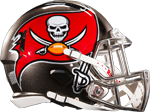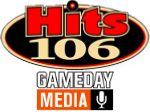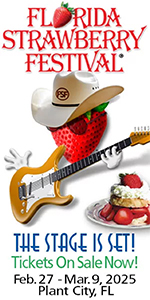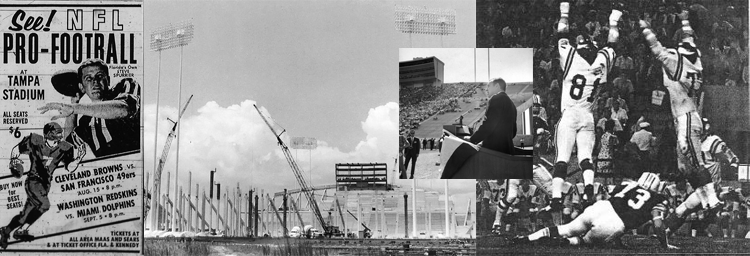
THE FIRST PRO GAME IN TAMPA
The first professional football game in the Tampa bay area was between the Chicago Bears and the Tampa Cardinals. The game was played at Plant Field on January 1, 1926. The Bears were led by rookie Harold “Red” Grange and the Cardinals were a pickup team put together by Jim Thorpe. The game itself was billed as a clash of old vs. new, with Grange, the rising star, taking on Thorpe, the aging legend.
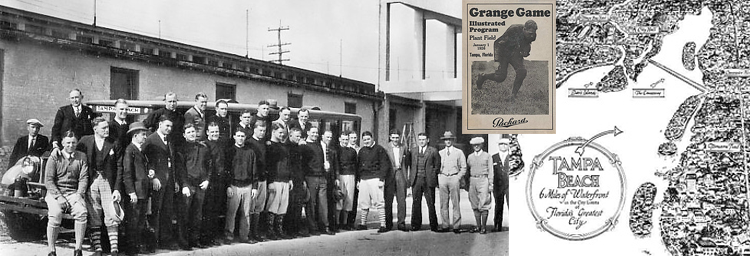
Shown above, Red Grange and his "Chicago Bears" pose at Plant Field on December, 30th, the day before the big game. At the time Tampa Beach was a planned development to be located at the southeast end of the 22nd St. Causeway, at the entry to McKay Bay, that became a victim of the 1920's land boom crash that put an end to the Tampa Beach plans.
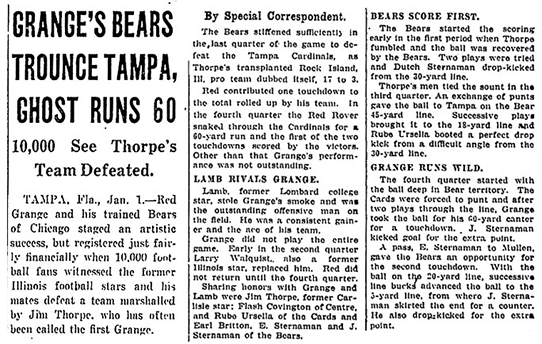
Plant Field was the first large spectator sports facility in the area. It was built in 1889 by Henry B. Plant across the Hillsborough River from Tampa as part of his Tampa Bay Hotel resort. As the only facility of its kind in Central Florida, Plant Field hosted a wide variety of events, including auto and horse racing; pro, college, and high school football; and large political events. It was also the long-time location of the Florida State Fair, and the route of the Gasparilla parade would end on Plant Field's track while the fair was in session.
Mr. Grange attracted quite a bit of attention while in town. Nowdays visiting teams recieve a police welcome escort, as shown a Temple Terrace officer issues a VIP speeding ticket instead. He was at the Temple Terrace Country Club on January 3, 1926, for an event to kick off the winter golf season. The match featured British Open champ Jim Barnes paired with future U.S. Open winner Johnny Farrell against Gordon Gibbons, the amateur champion of Florida, and Lawrence Sherill, the amateur champion of Tampa.

After leaving the Temple Terrace Country Club, a Packard automobile driven by Grange exceeded the posted speed limit while en route to an orange grove. A motorcycle cop pulled over the luxury vehicle, whose occupants included Barnes and Farrell, as well as Olympic silver medal-winning swimmer Helen Wainwright, and the owner of the vehicle, Joe Mickler. A photographer who had just finished snapping photos of the athletes came upon the scene and took one final image for posterity. Grange would leave Tampa with more than just a traffic ticket, however, as he also purchased $15,000 worth of property on the Forest Hills Golf and Country Club, the present-day site of the Babe Zaharias Country Club.
Helen Wainwright participated in one of the many promotions for D.P. Davis in 1926. She also bought property on Davis Islands. Davis created a carnival-like atmosphere around his land sales, sponsoring boat races around the Islands and along Bayshore Boulevard, airplane exhibitions with stunt flyers, sports celebrities such as Olympic swimmer Helen Wainwright, who swam around Davis Islands, plus tennis tournaments and golf lessons from tour professionals Bobby Cruickshank and Johnny Farrell.
Pre-Tampa Stadium & The AFL

In 1961 Mayor Julian Lane commissioned a study on the feasibility of a football stadium in Tampa. The University of South Florida was considered as a site, but the relatively new school did not want the stadium. There was not enough support for the plan; USF was in its infancy then and Dr. John Allen (president of USF at the time) was not an athletics type guy. He knew that if the stadium was built there, he wouldn’t have a choice but to support athletics at the school. In addition to Dr. Allen’s hesitancy, there was little public support for a tax-funded stadium. So the building of a Tampa football venue was shelved.
Phillips Field

The lack of a big stadium didn't stop the American Football League from coming to Tampa in 1964. In the early days of the AFL, teams from the league barnstormed the country playing exhibition games to try and help with marketing versus the more established NFL. The Buffalo Bills defeated the New York Titans 26-13 at the University of Tampa’s Phillips Field. The main football stadium in the Tampa bay area during the 1950s, it was a 12,000 seat stadium used by the University of Tampa Spartan football team. The small stadium was only half-filled, no doubt causing the AFL’s leaders to assume that Tampa was not too interested in their league.
Phillips Field shown in photograph in the late 1940s, looking north. Heading northward from from the stadium is Garcia Avenue, which went through the center of the area known as "Roberts City." North Blvd. is at the upper left corner, and the Fortune St. bridge, now the Laurel St. Bridge, can be seen at upper right. Cass St. was just south of the buildings you see at the bottom edge of this photo. The stadium area is now Tampa Preparatory School and just north of it is Julian B. Lane Park.
Located on the banks of the Hillsborough River, Phillips Field served as the home for the University of Tampa's football team from 1936 to 1967. The stadium was named after local businessman Isham Whitfield Phillips, whose family donated the land to the University of Tampa for construction of the field. It enabled the Spartans to have their own stadium and not have to schedule their games around various events at Plant Field. The stadium also served as the site for the annual Thanksgiving Day high school football game between Hillsborough and Plant, as well as the Cigar Bowl, a postseason college football game held from 1947-54. Phillips Field also hosted an American Football League exhibition game in August 1964 between the Buffalo Bills and New York Titans.
One particular incident involving the University of Florida highlighted Phillips Field’s shortcomings. UF students had a bad experience at Phillips when the Gators played the University of Kentucky. Not all of the students could get in to see the game and that led UF to decide not to play in Tampa. For a town Tampa’s size, it needed a better stadium to attract schools and help out the University of Tampa which had a good small college football team.

Tampa's Cigar Bowl was a post-season college football bowl game played at Phillps Field from 1947 to 1954 featuring small college teams. In some years, the game was part of a month-long "sports circus" in Tampa, with college basketball, golf, and tennis tournaments scheduled around the area along with horse racing and boxing.
The Cigar Bowl itself was sponsored by the local Egypt Temple Shrine as a fundraising event. After a few years, the limited capacity of Phillips Field (20,000 with temporary bleachers) and the rising cost of hosting the game caused the organization to rethink its sponsorship.
The Shriners discontinued support in 1955, and the bowl folded. There were several attempts to revive the game as a major bowl in subsequent years, but the lack of a larger venue made drawing top college teams impossible.
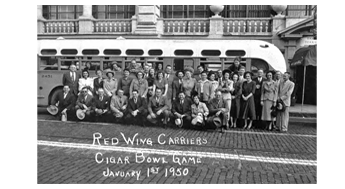
Employees of Red Wing Carriers gather at their bus in front of the Tampa Terrace Hotel on Florida Avenue, downtown, before heading to Phillips Field for the Jan. 1, 1950 Cigar Bowl game.
By the 1960s, however, most major college programs began refusing to travel to Tampa because of the small capacity of Phillips Field. The construction of Tampa Stadium in 1968 marked the end of the road for the venerable old field. Today, the former site of Phillips Field is used as an athletic field on the campus of the Tampa Preparatory School.
The next AFL experience with the Tampa bay area was even worse. The 1966 expansion Miami Dolphins opened training camp at Boca Ciega High School on St. Pete Beach and were shocked at what they found. The high school field was new sod laid over a base of ground up seashells. The effect of being tackled on such a field was brutal.
To add insult to injury, the Dolphins were housed in a hotel next door to the old Aquatarium where the players were kept awake all hours of the night by barking seals. You'd think the Dolphins would have felt right at home, but they fled the bay area after less than a month and didn’t come back again until years later.
All these bad experiences could be traced to the fact that the Tampa lacked a first rate stadium.
Formation Of The Tampa Sports Authority

Terrell Sessums,, shown in photograph in 1961, 1968, as Speaker of the House in 1973 and recently as member of Board of Governors of the Florida Chamber of Commerce and as a Trustee of the United Methodist Higher Education Foundation.
Before he became Florida Speaker of the House, Terrell Sessums read the study from 1961 realized that some of the issues that made a stadium unfeasible were less burdensome with a piece of property already owned by the city. Sessums reviewed the studies and projections, including the number of games that would be needed to be played to pay for a stadium. He found that the city held title to a large piece of federal surplus property along Dale Mabry Highway. The city had bought the 720 acre parcel from the federal government in 1949 with the idea of eventually building a community sports complex. At the time, the city was only using a small portion of it for the Cincinnati Reds spring training operation, known as Redsland.
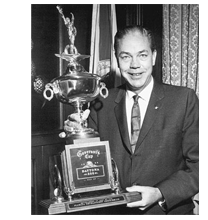
It also occurred to Sessums that the Florida Legislature could transfer title for the land from the city/county to another entity without cost, and that the city could create an authority called the Tampa Sports Authority, that could receive title for this land.
There was a great deal of support for the plan. The University of Tampa was very interested because they felt with a bigger stadium they could attract bigger schools and increase attendance. The University of Florida also felt they could be persuaded to play one major game a year. This would create a revenue stream that would help pay for the stadium.
With the civic leaders of Tampa on his side, Sessums was able to successfully move his bill through both houses in Tallahassee. But the governor of Florida, Haydon Burns, stated that he was going to veto the bill because he felt it was unconstitutional. “The governor said he was going to veto the bill because he should be the one to name members of the authority and that they could not be named in the bill,” Sessums said. “I pointed out that I thought it was constitutional and suggested that the governor have it reviewed by the Attorney General in an advisory opinion.”
Though Sessums was a relative newcomer to Tallahassee, he knew how to play the political game of hardball. Not being a supporter of the governor, Sessums was not intimidated and stood toe to toe with the executive office. “I talked to one of the governor’s floor leaders in the House and told him I had a dilemma. I told him the governor was thinking of vetoing the bill and that in some ways I would love for him to veto it because in the forthcoming election we could really clean his clock in our part of the state because it was a popular piece of legislation.”
Sessums' friend went straight to the governor and informed him of the political risk of vetoing the legislation. The next day the governor called Sessums and told him it was okay and they should all come down and have their pictures taken at a bill signing ceremony.
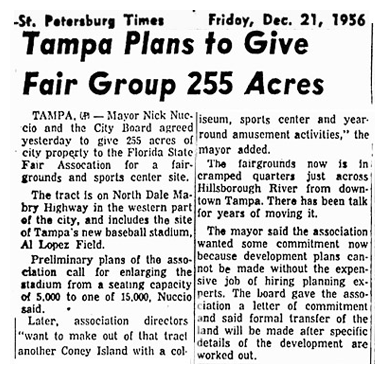
On May 28, 1965 Florida governor Haydon Burns signed the bill into law. With the ability to sell bonds and a piece of property for a stadium, the Tampa Sports Authority set about the process of constructing Tampa Stadium.
Tampa Stadium
The architectural firm of William Watson and Company designed Tampa Stadium. The company chose to base their design of the stadium on the Liberty Bowl in Memphis, Tennessee. Ground was broken on Tampa Stadium in October of 1966 on the large grassy lot along Dale Mabry Highway next to Al Lopez Field, the then-home of the Tampa Tarpons Florida State League baseball team and the spring training site of the Cincinnati Reds. Ample parking was available in large lots surrounding the stadium, as well as at nearby Horizon Park (now Al Lopez Park) and Jesuit High School.
Ten years earlier, this site was considered as the new location of the Florida State Fair.

Construction was completed on time and on budget. The total bill was 4.6 million dollars, with construction costs 4.1 million and soft money such as architects, studies and such at half a million. Tampa Stadium was part of a vanguard of the way sports venues would be built in the 1960’s and 1970’s. Aluminum bleachers rather than wood were used to house a capacity crowd of 46,477 on the permanent, sideline bleachers, and were arranged on a single tier, so that every seat had a direct and unobstructed view of the action. The original stadium capacity could be increased to 51,000 with temporary end zone bleachers, which were often used in the later years before the expansion.
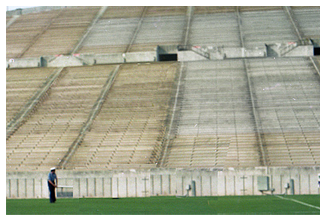
The grandstands along both sidelines extended several stories into the air, supported by a series of pre-stressed concrete columns of various heights under the superstructure. The benches were in two colors, with the majority in a bronze colored tint, with the lower-central benches in a natural aluminum tint forming the letter "T". The natural grass playing surface was highly crowned to provide rapid drainage during Florida's intense thunderstorms, with the sidelines 18 inches lower than the center of the field. This design allowed for the same number of seats as a double-decker stadium without the need for support columns inside the seating area that could block the view of the field. Although the 1960’s version of the stadium had the familiar triple-decker press box and two extremely high and unbroken grandstands along both sidelines, it lacked the enclosed end zones--it was possible to see the field of play from outside the stadium, a quaint quirk that would not exist for long.
The Early Games At Tampa Stadium

On November 4, 1967, the stadium hosted its first sporting event when the "Tampa U" Spartans hosted the University of Tennessee Volunteers. The Spartans lost that game, a 38-0 shellacking by the more nationally regarded University of Tennessee Volunteers. The fans in the stands may not have liked the result of the game, but the stadium itself was a big hit. The University of Tampa agreed to play as many as seven games a year at the stadium. The Spartans would later enjoy much success in their new home, moving up to Division I football in 1971. In later years, attendance at the Tampa U games did not meet expectations and university president B.D. Owens said the school would face bankruptcy if it continued to subsidize the sport. At the end of the 1974 season, UT shut down its football program.

The University of Tampa Spartans football team was the primary tenant of Tampa Stadium, but in order for the stadium to pay for itself, other teams were needed to play at the facility. One such team was the University of Florida Gators. The Gators were to play the Air Force Academy Falcons in 1968 but then decided they didn't want to play the extra road game, according to Sessums. Tampa bay area leaders met in a closed-door session with UF officials and according to Mr. Sessums, made clear what UF was endangering by their actions. “They were told that if they didn’t play this game they'd better never ask for another dollar.”
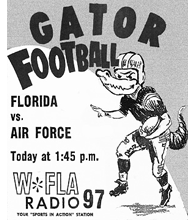
Needless to say, the Gators agreed to play the game, and went on to play a game a year here for nearly 15 years. During the 1968 contest with the Air Force Academy, a thrilling 23-20 victory for the Gators, the Air Force mascot elected to make Tampa his permanent home. “When they launched the Falcon at halftime, he flew off never to be seen again,” Mr. Sessums recalled with a laugh.
Tampa Pro Football Exhibition Game
Hoping to attract an NFL expansion team, community leaders arranged for several exhibition games in Tampa Stadium in the late 1960s and early 1970s. Beginning in 1968, the stadium played host to three pro football exhibition games. The Washington Redskins and Atlanta Falcons came to Tampa Stadium for the first time in August. Billed as the NFL Suncoast Classic with proceeds going to the Tampa Jaycees, the game drew a near-sellout crowd. More than 42,000 spectators watched the Redskins defeat the Falcons 16-14.
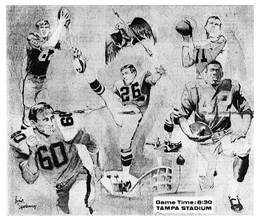
The initial game was such a success that Marcum promoted several more games at Tampa Stadium with furniture magnate Harry Mangurian as a financial backer. In all, eleven more games were held in the following seasons with similarly enthusiastic crowds, including the Baltimore Colts playing three of their “home” games here in 1972.
As 1969 began, Tampa Stadium had just completed its first full year of operation. The stadium played host that previous year to high school and college football games, and hosted an NFL exhibition game as well.
The Lions American Bow a.k.a. American Bowl College All-Star Game
The first major event of 1969 to be held at the stadium would be the first annual American Bowl, played on Jan 4th. The game, sponsored by the West Coast Lions Club, would feature all-star college football players from programs around the country.
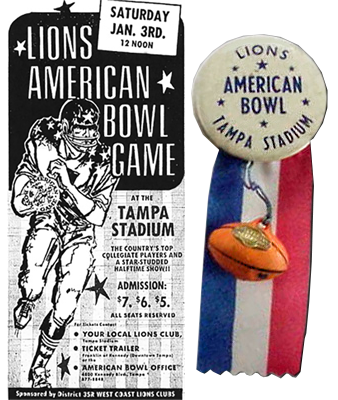
The game, originally known as the All-America Bowl, showcased a who's who list of college standouts who would go on to future glory in the NFL. The North squad featured Notre Dame linebacker Bob Kuechenberg, Kansas quarterback Bobby Douglass, and Penn State tight end Ted Kwalik, while the South team touted University of Florida running back and Tampa-product Larry Smith, University of Miami defensive end Ted Hendricks and running back Eugene "Mercury" Morris from West Texas State.
The coaching staffs of both teams were no slouches, either. Legendary Alabama Crimson Tide head coach Paul "Bear" Bryant led the South squad, where he was joined by Ray Graves of the University of Florida, Fran Curci of the University of Tampa and College Football Hall of Famer Frank Broyles from the University of Arkansas.
The North was led by Purdue coach Jack Mollenkopf. His staff included coaches Pepper Rodgers of Kansas and Navy's Lee Corso. More about this game. The Lions American Bowl games continued until 1977.
Only 16,280 attended the soggy first showing of the American Bowl, and the event lost $40,000 in revenue. Despite the bowl's disappointing debut, where the South lost to the North, 21-15, planners continued to schedule the event for the next year.
NFL Football At Tampa Stadium

Two more exhibition games were played in 1969 – and a regular-season AFL game between the Miami Dolphins and Boston Patriots in November 1969. All were well-attended affairs--averaging 35,214 fans per game--with only the AFL contest drawing fewer than 30,000. Between 1968 and 1971, teams such as the Minnesota Vikings, Boston Patriots, Miami Dolphins, Cleveland Browns, New York Jets, and San Francisco 49ers played August exhibitions at Tampa Stadium. All the games played to either sell-outs or near capacity crowds with a 1971 contest featuring Joe Namath and the New York Jets setting an attendance record of 51,214.
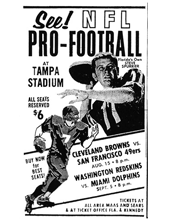
The goal for the showdown Aug. 15, 1970 between the Cleveland Browns and San Francisco 49ers was to exceed the attendance high of 40,915 set in 1968. In the days leading up to the game, it appeared by all calculations that it would be a reality. The games, organized by local promoter and Tampa Jaycees president Bill Marcum, were showcases intended to highlight the viability of the Tampa Bay area as a pro market. Healthy attendance figures were obviously a source of pride, and Marcum hoped San Francisco and Cleveland would help fill Tampa Stadium’s benches. The two franchises were originally members of the All-American Pro Football Conference from 1946-49 before being absorbed by the NFL in 1950.
Under third-year coach Dick Nolan, the 49ers were thought of as somewhat of an up-and-coming team. The Browns, meanwhile, were one of the most-successful franchises in football, winning NFL titles in 1950, 1954, 1955, and 1964. In fact, the team had only one losing season in its entire history, going 5-7 in 1956.
The contest had local interest as well. The 49ers had two starters with Tampa roots – center Forest Blue of Chamberlain High School and defensive tackle Earl Edwards of Blake High School – while the Browns featured another Chamberlain product and Florida State University standout, tight end Chip Glass.
The game’s biggest draw was University of Florida product and 1966 Heisman Trophy winner Steve Spurrier. The 49ers drafted him in the first round of the 1967 entry draft, but Spurrier spent the majority of his time as the punter and second-string quarterback behind John Brodie. The game in Tampa would mark Spurrier’s first time playing in Florida as a pro. Spurrier would once again serve as Brodie’s backup, but split equal time throughout the contest.
Despite a heavy pregame rain and horrendous traffic jams on Dale Mabry Highway and Himes Avenue, a near-record crowd of 41,851 fans made it into the stadium.
An accident at 6 p.m. on the Interstate 4 (now I-275 South) exit ramp at Dale Mabry involved police officers on their way to help control traffic and contributed to the massive gridlock, so many motorists simply decided to park by the interstate and walk to the Stadium.
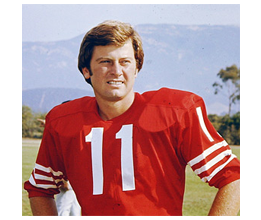
Anyone who came to see Spurrier play was not disappointed. After sitting out the first half, Spurrier played throughout the entire second half of the game, completing 12 of 19 passes for 175 yards--a performance which should have won the game for them. But his offense committed critical turnovers – a fumble by Bill Tucker, and interceptions from Spurrier and running back Larry Schrieber ended three potential scoring drives.
The Tucker fumble came at the worst time, as the 49ers were driving down the field with time running out and trailing 17-10. On fourth-and-seven at the Cleveland 17, Spurrier found Tucker for a nine-yard gain – good enough for the first down – but Cleveland forced a fumble and recovered the ball at the seven yard line, effectively ending the game.
San Francisco owner Lou Spadia came away extremely impressed with Tampa, calling it “football country” and the “best non-league football city in our experience.” Cleveland owner Art Modell praised Tampa for the excellent turnout despite the inclement weather, noting that the city remained well on the NFL’s expansion radar. “What a tribute to the community,” Modell said. “What a stadium. You’re high on the highest plateau as an expansion city for a franchise when it happens.”
Marcum, meanwhile, lamented the loss in revenue due to the inclement pregame weather and parking problems outside the stadium. “We’d have sold out, “Marcum said afterward, “if only it hadn’t rained.”
The Push For A PRO Franchise In Tampa
According to Leonard Levy, the success of the exhibition games changed the minds of many Tampa Bay civic leaders as far as being an NFL city was concerned. Originally Tampa Stadium was built for college football, but the sell-out of games between out of market teams made some feel Tampa should have a team of its own. “In 1966 we weren’t even thinking of being an NFL city. It wasn’t until about 1969 that we thought we might have a chance to get one. The success of the pre-season games was a big factor.”
Stadium director Joe Zalupski was in charge of managing Tampa Stadium during these events and recalls the summers of 1968 to 1972 as being a very busy time. “We hosted more pre-season NFL games than any other site in the United States except those that already had a franchise.”
Zalupski further explained that the pre-season games were proof of Tampa’s emergence as a national city. “The economic evolution of Tampa had begun. We were rising as a television market. Growth occurred by leaps and bounds.”
What made Tampa so popular a pre-season site were not only the sell-out crowds but also the quality of the stadium. Tampa Stadium received rave reviews about the playing surface. Players loved the Bermuda grass surface during a time when most facilities were installing rock-hard Astro-Turf and owners loved the drainage system that kept the field dry and protected their expensive investments. See Success At The Grass Roots Level about Pursley, the turf at Tampa Stadium.
Joe Zalupski said the man most responsible for the playing surface’s popularity was Tampa Stadium superintendent Dave Ritchie. “Dave was my superintendent and first hire in 1966,” Zalupski recalled. “He was probably as important to me and the stadium as anybody as both a friend and technician. He had a pride about himself and the field was important to him.”
August 7, 1971 New York Jets vs. Detroit Lions
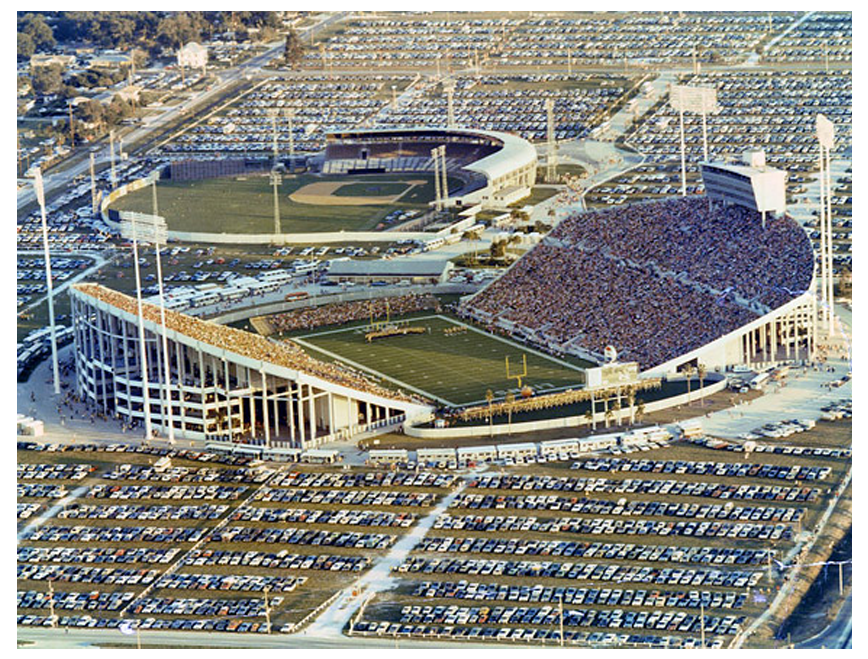
Above: August 7, 1971, shows a then-record crowd of 51,214 at Tampa Stadium for a National Football League exhibition game between the New York Jets and Detroit Lions. Notice the temporary bleachers set up in the end zones.
For Tampa football fans, the game was the sixth in a series of exhibition games from 1968-1975 designed to highlight the area’s viability as a market for professional football. Unlike most years when the stadium played host to two games, this would be the only game scheduled at Tampa Stadium during the 1971 exhibition season.

Detroit ended up defeating New York 28-24, but the game is best remembered for an injury to New York’s Joe Namath. With 5 minutes left in the first half, and the Jets leading 14-0, the Jets gave the ball to Lee White for a run around the right end. White fumbled, and Namath attempted to tackle the Detroit linebacker – Mike Lucci -- who made the recovery. While Lucci would go on to score a 29-yard touchdown, Namath tore ligaments in his left knee when blocked by Detroit's Paul Naumoff.** The injury would keep him sidelined for all but four games in the 1971 season. The suddenly injury-prone former MVP of the American Football League had played in only five games the previous season due to a broken wrist.
**Some accounts say Namath was injured while trying to tackle a Detroit Lions player who had intercepted his pass.
Romancing The Colts
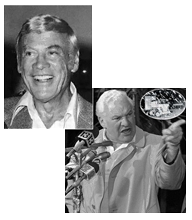
The pre-season sell-outs and stadium quality so impressed one NFL owner that Tampa almost found itself with a team in the early 1970’s. Carroll Rosenbloom became very interested in Tampa and once tried to move the Colts to Tampa. NFL Commissioner Pete Rozelle told him that was not going to happen, but Rosenbloom still scheduled all of Baltimore’s 1972 exhibition games at Tampa Stadium. Before the season, Rosenbloom pulled the trade that gave him the Los Angeles Rams and Robert Irsay the Colts.
That year, Irsay, a native of Chicago, bought the Los Angeles Rams for $19 million and promptly traded the rights to the team to Carroll Rosenbloom for his franchise, the Baltimore Colts. So Irsay owned the Colts when the team came to Tampa.
Irsay went on to move the Colts to Indianapolis in March 1984 in a wildly unpopular move, with ownership of the franchise switching to son Jim in 1997 after Robert's death.
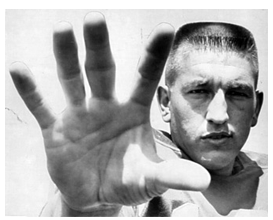
In the summer of 1972, the Baltimore Colts played three pre-season games in Tampa--against the Redskins on Aug. 4, the Steelers on Aug 26, and the Lions on Sept. 1. Rumors quickly spread that the Colts were contemplating moving to Tampa and there were even some bumper stickers around that read "Don't Tampa with our Colts."
Rosenbloom may not have moved his team to Tampa, but according to Leonard Levy, the Colts owner was crucial in getting a team for Tampa by demanding that expansion be put on the NFL’s agenda in the early 1970’s. “Our biggest barrier was in getting the NFL to put expansion on the agenda,” said Levy. “When congress permitted the AFL-NFL merger, one of the things Rozelle had testified was that the league would have a standing expansion committee and it would mean more cities would get teams. Well, they did not have a committee, or at least it was not active. We would go to Rozelle and he would tell us, ‘I don’t prepare the agenda, the owners do.’ We would go to the owners and they would tell us, ‘We don’t prepare the agenda, Rozelle does.’ Fortunately, we had two friends in Carroll Rosenbloom and Lamar Hunt. They insisted that it be put on the agenda and that is how it came that the league voted for expansion.”
Tampa Stadium 1973 Pre-Season Games
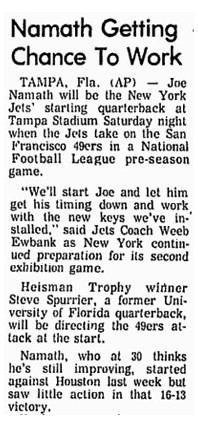
Tampa Stadium hosted two pre-season games in 1973 with the New York Jets against the San Francisco 49ers and the Philadelphia Eagles.
Aug. 11, 1973 - York Jets coach Weeb Ewbank announced that holdouts Emerson Boozer and Winston Hill will not be on the team for tonight's exhibition game against the San Francisco 49ers.
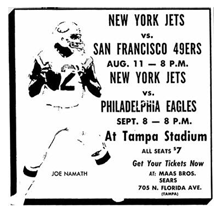
Jets Victors, 34-14, On 49er Turnovers - Namath Looks Sharp Jets Rout 49ers, 34-14, With 3 Key Players Out
With their 34-14 preseason victory over the San Francisco 49ers here last night, the New York Jets, who once equalized the entire American Football League with the older National League on the strength of one victory, equalized their chances against the New York Giants, their opponents next Sunday.
Tampa's Hope Turns To Expansion
With expansion now a certainty, the job of winning a franchise for Tampa Bay fell on the shoulders of Leonard Levy. A printer by trade, Levy was also a major supporter of football in the state of Florida. “Sports has always been my avocation, printing is how I made my living,” Levy admitted recently. “I’m a Florida Gator. I’m probably a bigger college football fan than a pro football fan. I’ve missed only eight Gator games in Gainesville in forty-five years.”
While he may have been a Gator at heart, Levy was also a member of the Tampa Sports Authority and as of the early 1970’s he was named Chairman of Tampa’s NFL Task Force Committee. Before Levy could persuade the NFL to expand to Tampa, he needed to make sure that he had all the local support he could muster. To do this Levy knew that he needed to make it clear that it was not just the city of Tampa that was petitioning for a franchise, but the entire Tampa bay area. “Tampa by itself could not have supported a franchise, let’s be honest,” Levy said. “It might today but not back then. The market area of Tampa and St. Petersburg was certainly big enough though. Tampa Bay is a body of water that separates the two counties, but we felt using the name Tampa Bay would solidify the area.”

It worked, and when Levy met with community leaders from every city in the Tampa bay area he found it very beneficial in the political game of landing a franchise. “The whole area was supportive. In fact at a meeting we appointed a task force of about 100 people from all over and told them. ‘What we need from you is any contacts you have from around the country. If any of you has any friends who is a friend of an owner let us know about it, you could open a door for us.’ Somebody came up to me after the meeting and said that he knew Ralph Wilson’s (owner of the Buffalo Bills) roommate from college.”
Networking such as this, plus the exposure Tampa had received as the host of multiple pre-season games made the job Levy had of selling the community a little bit easier. After years of meeting one-on-one with all 26 owners, Pete Rozelle and civic leaders, Leonard Levy boarded a plane and flew to New York in April of 1974. The NFL was prepared to announce the awarding of the league’s 27th franchise. Tampa Bay was in close competition with Seattle, Phoenix and Honolulu.
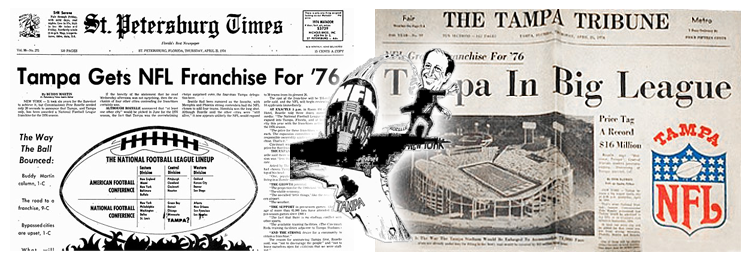
April 24, 1974 - Tampa Awarded A NFL Franchise
At precisely 5 p.m. on April 24, 1974, Pete Rozelle walked into Suite 404 of the Drake Hotel, sat down in a straight chair, shook hands with a New Jersey writer, and three minutes later told the 31 people there: "The National Football League today voted to expand to Tampa, Florida, and to at least one other city to be chosen later this year. The teams are to be ready for the 1976 season. The franchises will cost $16 million each." And with that, Tampa was to be the NFL’s 27th franchise. The newspapers of the day reported that Leonard Levy exclaimed, “Godamighty, Godamighty!” upon hearing the announcement. Mr. Levy recollects a calmer acceptance of the news, although he is still proud of that moment. “We felt like we were in good shape so it wasn’t a total shock when it was announced.”
After Rozelle announced Tampa as the winner, he said, ‘We have Leonard Levy here, let me get Leonard up front.’ "That is one of those memories you won’t ever forget" said Levy. "I’m a small-town guy and I walked up to the front of that room with all the cameras snapping, that was quite an experience for me. I’ve got a picture of me in my office with Pete Rozelle shaking my hand.”
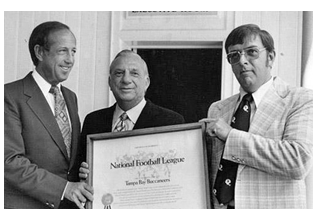
Among those vying for the rights to purchase the Tampa Bay franchise was Harry Mangurian and Bill Marcum who had supplied the money and effort behind the series of successful exhibition games. The winner of the bid turned out to be Tom McCloskey, a wealthy construction and real estate developer from Philadelphia.
McCloskey only owned the franchise for a short time. So short in fact, that he didn’t last long enough to see the team christened the Buccaneers. When McCloskey left the team was still referred to as the Tampa Bay franchise. The reasons for McCloskey’s decision to abandon ownership came down to one thing: money. With the nation in the grips of a recession in 1974, McCloskey was fearful that owning a start-up franchise would eat away at too much of his capital. It was also rumored that McCloskey was afraid that his soon to be ex-wife would end up with half the franchise after a date in court.
Jacksonville tax attorney Hugh Culverhouse popped up with his checkbook and paid the 16 million dollars to become majority owner. Culverhouse would own the team until his death in the mid 1990’s. Culverhouse’s trust owned and operated the franchise for a short period of time until Malcolm Glazer purchased the team in 1995 for 192 million dollars.
Tampa Bay BUCCANEERS!
"Buccaneers" was chosen from dozens of suggestions in a public name-the-team contest. The story goes that the new pro team's owners already had Buccaneers in mind. They were just waiting for someone to enter it in the contest so they could pick it.

The Tampa Bay Buccaneers will take the field in their inaugural National Football League season attired in colorful uniforms and sporting an emblem which are unique and exemplify the bold , brave spirit of the entire Tampa Bay area.
Orange, red and white have been selected as the club’s official colors. Orange was a natural choice because of the area’s citrus industry and the warmth of Florida’s sunshine. Red, too, is warm and lively. In heraldry, it is symbolic of courage and fortitude in battle.
The Buccaneers will wear predominately white uniforms with orange and red striping and numerals.
The logo, designed by award-winning Tampa Tribune artist-cartoonist Lamar Sparkman depicts a handsome Buccaneer, wearing a rakish plumed hat, boldly winking and clenching a dagger between his teeth.
Artist Sparkman admitted that he sought a corsair of the cut of Errol Flynn, Jean LaFitte, or Musketeer D’Artagnon
Tampa Stadium Expansion Adding End Zones & Skyboxes
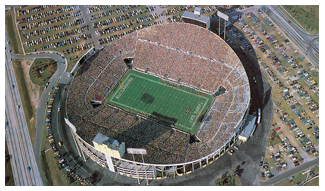
Before the newly-named Buccaneers arrived, Tampa Stadium underwent an extensive expansion project throughout 1975. Over 27,000 seats were added by completely enclosing the previously open end zones, making the facility one of the largest venues in the NFL. The construction was barely finished by the time of the Bucs' first pre-season home game.
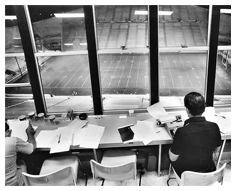
Luxury skyboxes were also added to the East Side and in 1976, the open space between the bottom level of the press box and the uppermost rows of bleachers was enclosed, thereby increasing the size of the press box facilities. The stadium was later dubbed "The Big Sombrero" by ESPN's Chris Berman for the Mexican undulating hat or wave-like shape created along the top of the stadium by this expansion project. The expansion increased capacity from 46,000 to 72,000 and made Tampa Stadium one of the largest in the National Football League. It also became one of the NFL’s coveted venues. Other major sports were also anxious to use the facility.
Tampa Stadium's First Professional Sport Tenant
The "OTHER" Football sport... Tampa Bay Rowdies were Tampa Stadium's first professional tenant. They opened their inaugural outdoor soccer season on Saturday night, April 26, 1975 at Tampa Stadium against the Rochester Lancers.
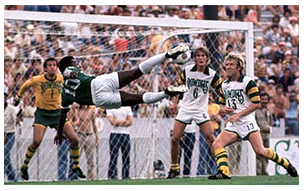
The opening kick off culminated nearly a year of building the franchise from scratch. It began with the North American Soccer League awarding a franchise to millionaire George Strawbridge, who also owned a large portion of the NHL Buffalo Sabres. General Manager Beau Rogers was lured away from a similar position in Philadelphia. Eddie Firmani, a South African who starred in the English and Italian Leagues, was hired as head coach. At the time, he was 41 and still a capable player--his name was even on the playing roster. Clyde Best, the Rowdies English League First-Division superstar missed the game due to starting in the English league's FA Cup finals with his team, West Ham United. The Rowdies lineup was described as "speed, finesse and scoring power up front and hard-nosed rough'em up defense at the other. Left-footer Doug Wark, newly-arrived Derek Smethurst, and Bernard "Dancing Shoes" Hartze made up the front line attack. The midfielders and defenders were led by stubby John "The Bull" Boyle, rookies Randy Garber, Farrukh Quraishi, and John Blueum had English stalwarts John Sissons, Malcolm Linton and teenager Michael "The Computer" Connell for company defending, and goalkeeper Scotsman Mike Hewitt.
The Rowdies won their only outdoor championship in San Jose, CA against the Portland Timber during the team's first season in 1975. They played their home games in Tampa Stadium until the North American Soccer League disbanded in 1984.
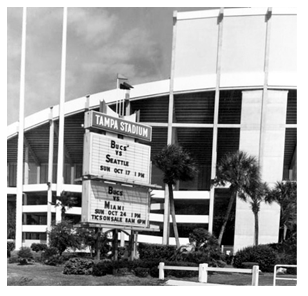
Rowdie vs. NY Cosmos At Tampa Stadium
The star-studded NY Cosmos were arch-rivals of the Rowdies. In June 1976 the Rowdies demolished the NY Cosmos 5 -1, in front of 42,611 Tampa Stadium Fannies and a National television audience.
45,288 Fannies packed Tampa Stadium on May 29, 1977 to watch the Rowdies trounce the Cosmos, who were led by superstar Pele, 4 -2 and spoil German league superstar Franz Beckenbauer's debut. It was a sweet day in Tampa Bay Rowdies history. Two goals from Steve Wegerle, one from Rodney Marsh, and one from Ian Anderson.
On June 14, 1980, the Rowdies defeated the Cosmos at Tampa Stadium, 4-3 in a "shootout" tiebreaker, the NASL's answer to FIFA's penalty kicks tiebreaker. 54,247 fans filled Tampa Stadium to make it the largest crowd to attend a soccer match here.
Florida State Fair At Tampa Stadium
In February of 1976, the Florida State Fair had moved from its location at Cass St. and North Blvd. but the new facility at US 301 and I-4 wasn't ready, so the fair was held at Tampa Stadium. The midway was set up in the parking lots, and exhibits were displayed under the stands. There was no sprint car racing that year.
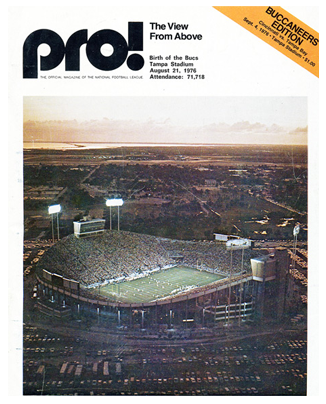
The Buccaneers At Tampa Stadium
The Buccaneers' first regular season home game was held on September 19, 1976, when the home team lost to the San Diego Chargers 23-0. That would become a trend, as the team began their existence with an NFL record 26 game losing streak. They would not win a game on their home field until defeating the St. Louis Cardinals on the last game of the following season, December 18, 1977. Jubilant fans swarmed the Tampa Stadium turf and tore down the goal posts.
Shown in photograph a Sept. 4, 1976 pre-season game program between the Bucs and the Bengals shows view of Tampa Stadium on Aug. 21, 1976 for Bucs vs. Dolphins pre-season game
More Tampa Stadium Renovations
Tampa Stadium's last major renovation took place in the early 1980s in preparation for hosting its first Super Bowl. The stadium's press boxes were updated and the skybox structure on the East Stands was greatly enlarged by adding more suites to each end. This configuration gave the facility its maximum seating capacity of 74,301.
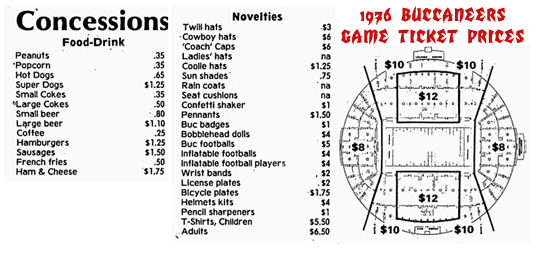
After coming off a 5-10-1 season in 1980, the Bucs improved to 9-7 in 1981, winning the NFC Central division over Detroit by one game. Tickets for the playoffs were offered first to season ticket holders, for the divisional and conference playoff games. In the divisional playoffs, the Bucs were crushed by the Dallas Cowboys in Dallas, 30-0. Dallas limited the Bucs to 24 rushing yards and forced 4 interceptions and 4 sacks. Image below shows the ticket which was to be for the 2nd round of the playoffs, the NFC Championship game.
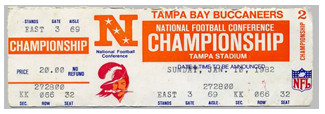

SUPER BOWL XVIII
On June 3, 1981, the NFL awarded Tampa Stadium its first Super Bowl: Super Bowl XVIII (18) which was held on January 22, 1984. During the Super Bowl balloting, Tampa beat Dallas, Detroit, Miami, New Orleans and Pasadena.

On January 22, 1984, the Los Angeles Raiders defeated Washington 38-9 before 72,920 at Tampa Stadium in Super Bowl XVIII. The Raiders posted the then-largest margin of victory in a Super Bowl en route to capturing their third Vince Lombardi Trophy.
RB Marcus Allen rushed for a Super Bowl-record 191 yards on just 20 carries, including a record 74-yard scoring jaunt at the end of the third quarter that cemented Most Valuable Player honors.
Los Angeles jumped out to a 7-0 lead when Derrick Jensen recovered a blocked punt in the end zone. The Raiders increased their lead to 14-3 when QB Jim Plunkett fired a 12-yard scoring strike to WR Cliff Branch. After K Mark Moseley booted a 24-yard FG to cut the lead to 14-3, Washington took an unnecessary gamble that proved to be disastrous. QB Joe Theismann attempted to throw a screen pass deep in Redskins territory, but LB Jack Squirek picked it off at the Washington 5 and waltzed into the end zone with seven seconds left in the half.
The Redskins cut the lead to 21-9 on a one-yard TD run by RB John Riggins early in the third quarter. But Allen took over from there, scoring twice before the quarter ended to ice the victory. The win ran Raiders head coach Tom Flores’ postseason record to 8-1. The 38 points scored by Los Angeles were the most in the first 18 Super Bowls, surpassing Green Bay’s 35 points in Super Bowl I.

SUPER BOWL XXV
On May 20, 1987, the NFL announced that Tampa Stadium would host Super Bowl XXV, the silver anniversary of the event. During the balloting, Tampa beat Anaheim, Los Angeles, Miami and San Diego. For the 1990 season, large flagpoles were mounted on the upper rim of the stadium as part of a renovation that included the addition of a JumboTron screen in the south end zone and smaller scoreboards above the field-level tunnels in two corners of the stadium. Total renovation costs to this point were $13 million.

Super Bowl XXV was played under much patriotic fervor, due to the Persion Gulf War "Desert Storm". It was held on January 27, 1991. The proceedings included a fly over by the 56th Tactical Training Wing, U.S. Central Command & U.S. Special Operations Command at MacDill AFB, a rousing rendition of "The Star-Spangled Banner" by Whitney Houston. Pete Rozelle performed the coin toss, and a half-time show produced by Disney, called "A Small World Salute to 25 Years of Super Bowls" featured New Kids on the Block. A capacity crowd saw the New York Giants defeat the Buffalo Bills, 20 - 19.
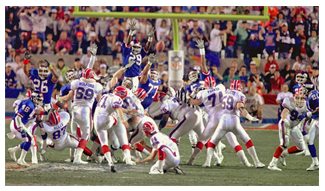
The game is best remembered for Bills placekicker Scott Norwood's last-second 47 yard field goal attempt which went right of the uprights, leading to a Giants victory and starting a four-game losing streak in the Super Bowl for the Bills, and has since become known as the "Wide Right Game". This Super Bowl remains the only one decided by one point to date in 2011 and the first one played without a turnover.

SUPER BOWL XXXV
On January 28, 2001, the Baltimore Ravens defeated the New York Giants 34-7 before 71,921 at Raymond James Stadium.
The Ravens’ suffocating defense allowed the Giants just 152 total yards and did not permit an offensive touchdown en route to winning Baltimore its first championship in team history.
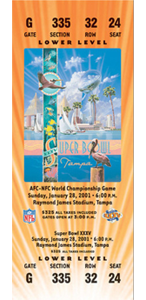
LB Ray Lewis, named the 2001 Defensive Player of the Year, totaled three tackles, two assists and four passes defensed against the Giants, while being named the Most Valuable Player of Super Bowl XXXV.
Former Buccaneer QB Trent Dilfer led the Ravens to their first score with a 38-yard touchdown pass to WR Brandon Stokley to give the Ravens a 7-0 first quarter lead. Dilfer later set up a K Matt Stover 47-yard field goal with 1:48 left in the first half with a 36-yard pass to WR Qadry Ismail.
RB Tiki Barber, twin brother of current Buccaneers CB Ronde Barber, gave the Giants their farthest drive into Ravens’ territory with a 27-yard run to Baltimore’s 29-yard line. However, CB Chris McAlister intercepted QB Kerry Collins’ pass on the next play to end the drive. CB Duane Starks intercepted Collins later in the third quarter and returned the ball 49 yards for a touchdown and a 17-0 lead. S Kim Herring and LB Jamie Sharper also recorded interceptions in the game.
WR Ron Dixon returned the ensuing kickoff 97 yards for a touchdown and cut the Giants’ deficit to 10. But WR Jermaine Lewis then matched Dixon’s kickoff return as he cut across the field and raced 84 yards for a 24-7 lead with 3:13 left in the third quarter. The three touchdowns in 36 seconds were a Super Bowl record.
RB Jamal Lewis, who finished with 27 carries for 102 yards, scored on a three-yard touchdown run midway through the fourth quarter and gave Baltimore a 31-7 lead. Stover finished off the scoring for the Ravens with a 34-yard field goal midway through the fourth quarter.

SUPER BOWL XLIII
On February 1, 2009, the Pittsburgh Steelers defeated the Arizona Cardinals 27-23 in dramatic fashion before 70,774 at Raymond James Stadium securing sole possession of the record for most Super Bowl wins with six.
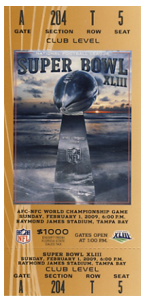
Pittsburgh outgained Arizona 158 to 102 yards in the first half of Super Bowl XLIII, jumping to a 17-7 lead at halftime, aided by LB James Harrison’s Super Bowl record 100-yard interception return for a touchdown, the longest scoring play in Super Bowl history. Harrison, the 2008 Defensive Player of the year, totaled four tackles, one pass defensed, two quarterback hurries and one interception. Trailing 20-7 at the start of the fourth quarter, Arizona scored 16 unanswered points, including WR Larry Fitzgerald’s 64-yard touchdown reception to take a 23-20 lead with 2:37 remaining in the game. The Steelers marched 78 yards to score on WR Santonio Holmes’ six-yard game-winning touchdown catch with 35 seconds left. Holmes finished the game with nine receptions for 131 yards and one touchdown, including four receptions for 71 yards on the final drive, earning him Super Bowl MVP honors.
Steelers QB Ben Roethlisberger recorded 256 yards passing on 21-of-30 attempts including one interception and the game-winning touchdown pass.
The Cardinals were led by QB Kurt Warner, who completed 31-of-43 pass attempts for 377 yards, three touchdowns and one interception. Warner connected with WR Anquan Boldin for a team-high eight receptions for 84 yards, while Fitzgerald led the team with 127 yards receiving on seven receptions, including two touchdowns.
Approximately 98.7 million people watched Super Bowl XLIII, making it then the most watched Super Bowl ever.
The Glazers & Houlihan's Stadium
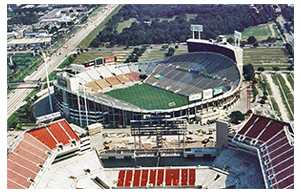
The stadium's name was changed after the Malcolm Glazer family purchased the Tampa Bay Buccaneers franchise in 1995. The Glazers also purchased the stadium's naming rights from the Tampa Sports Authority and officially changed the facility's name to "Houlihan's Stadium" to advertise one of the Glazer family's business ventures, the Houlihan's restaurant chain.
The Buccaneers' final game at Tampa/Houlihan Stadium was an NFL wild card playoffs game against the Detroit Lions on December 28, 1997, which the Buccaneers won 20-10. Horace Copeland and Michael Alstott each score a touchdown in the win. It was the Bucs' first playoff victory in 18 years. They went on to play the Green Bay Packers in Green Bay at the Divisional level and lost 21 - 7. The Buccaneers moved next door to newly-built Raymond James Stadium for the 1998 season.
Other Professional Sporting Events & Concerts
Tampa Stadium hosted a large annual USHRA monster truck rally in late January or early February (after football season, when turf damage wouldn't matter) for many years, and hosted equestrian show jumping competitions later in the spring. Both of these events are still held in Raymond James Stadium.

Many concerts were held in Tampa Stadium over the years, featuring major acts such as The Who, Jethro Tull, Paul McCartney, U2, The Rolling Stones, Jimmy Buffett, The Eagles, Whitney Houston, George Michael and Pink Floyd, among many others.
Two particularly memorable concerts were held there by the English rock band Led Zeppelin. On May 5, 1973 the band attracted 56,800 people, which at the time represented the largest audience for a single artist performance in history, breaking the record set by The Beatles at Shea Stadium in 1965.
Bandit Ball, The USF Bulls, MLS Mutiny Soccer "Football", CAN-AM - Pro & Outback Bowls
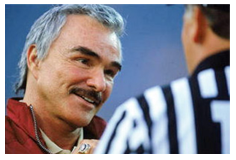
Tampa Bay Bandits
Between 1983 and 1985, the Tampa Bay Bandits, one of the twelve original USFL franchises, were the stadium's third professional tenant. The Bandits enjoyed strong ticket sales and fan support, and were one of the few 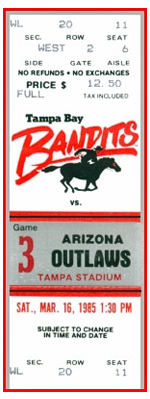 USFL teams to stay in their original city and stadium for the league's three seasons.
USFL teams to stay in their original city and stadium for the league's three seasons.
USF Bulls
The University of South Florida Bulls football team played its initial season at the stadium in 1997, becoming the stadium's second and final collegiate tenant. The Bulls played the final football game at the stadium on September 12, 1998, defeating Valparaiso 51-0 before moving to Raymond James Stadium for their next home game on October 3, 1998.
Tampa Bay Mutiny
Major League Soccer placed one of its original teams in Tampa in 1996. The Tampa Bay Mutiny were the stadium's fourth and final professional tenant. The Mutiny used the stadium as their home field for their first three seasons, and moved to Raymond James Stadium in 1999. They hosted the last sporting event at the stadium on September 13, 1998, when they defeated the New York MetroStars 2-1 in front of 27,957 fans.
Between 1977 and 1979, the Can-Am Bowl (a college all-star game) was played in the stadium. From 1986 to 1998, college football's Hall of Fame Bowl (later known as the Outback Bowl) was held there on New Year's Day. From the January 1999 contest on, the Outback Bowl has been played at Raymond James Stadium.
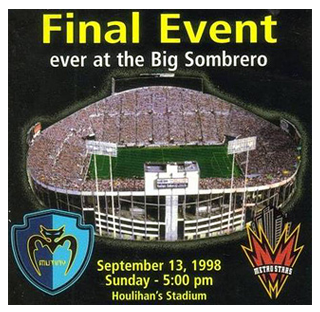
The End Of Tampa/Houlihan's Stadium
Upon buying the Buccaneers in 1995, new owner Malcolm Glazer declared that he might move the franchise to another city unless a new stadium was built at taxpayer's expense. To accommodate these demands, the community raised the local sales tax and built Raymond James Stadium just south of Tampa Stadium in 1997-98.

Demolition proceeded soon after the Tampa Bay Mutiny's final home game in September 1998. Wrecking balls and long reach excavators were used for much of the process. Crews first smashed lower sections of the north end zone seats and worked their way up. Then the crane moved counter-clockwise around the stadium, leaving the final blows for luxury boxes on the east side. The last portion of the stadium (the east side luxury boxes built for the stadium's first Super Bowl), was imploded on April 11, 1999. The land was then cleared and converted into a parking lot. Chunks of the stadium including sections of the bleachers were sold off as souvenirs.
Among the major sporting events that took place at Tampa Stadium were:
In addition to the Tampa Bay Buccaneers, the following tenants called Tampa Stadium home:

